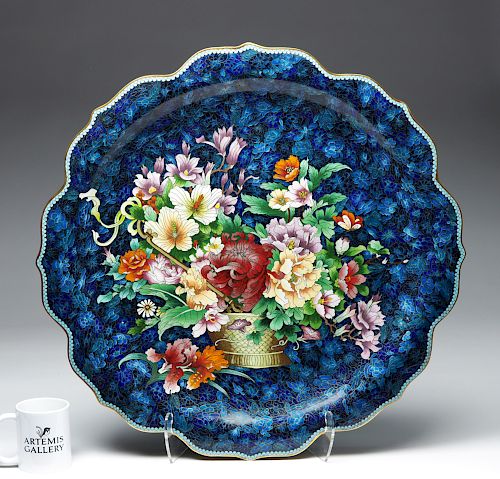Huge Chinese Qing Dynasty Cloisonne Charger
Lot 111a
About Seller
Artemis Fine Arts
686 S Taylor Ave, Ste 106
Louisville, CO 80027
United States
Selling antiquities, ancient and ethnographic art online since 1993, Artemis Gallery specializes in Classical Antiquities (Egyptian, Greek, Roman, Near Eastern), Asian, Pre-Columbian, African / Tribal / Oceanographic art. Our extensive inventory includes pottery, stone, metal, wood, glass and textil...Read more
Estimate:
$1,500 - $2,250
Absentee vs Live bid
Two ways to bid:
- Leave a max absentee bid and the platform will bid on your behalf up to your maximum bid during the live auction.
- Bid live during the auction and your bids will be submitted real-time to the auctioneer.
Bid Increments
| Price | Bid Increment |
|---|---|
| $0 | $25 |
| $300 | $50 |
| $1,000 | $100 |
| $2,000 | $250 |
| $5,000 | $500 |
| $10,000 | $1,000 |
| $20,000 | $2,500 |
| $50,000 | $5,000 |
| $100,000 | $10,000 |
| $200,000 | $20,000 |
About Auction
By Artemis Fine Arts
May 10, 2018
Set Reminder
2018-05-10 10:00:00
2018-05-10 10:00:00
America/New_York
Bidsquare
Bidsquare : Fine Ethnographic / Asian / Ancient Art
https://www.bidsquare.com/auctions/artemis-gallery/fine-ethnographic-asian-ancient-art-3213
Featuring antiquities from around the world including Pre-Columbian, Tribal, Classical, Asian, so much more! Artemis Fine Arts info@artemisfinearts.com
Featuring antiquities from around the world including Pre-Columbian, Tribal, Classical, Asian, so much more! Artemis Fine Arts info@artemisfinearts.com
- Lot Description
East Asia, China, Qing Dynasty, ca. 1644 to 1912 CE. Wow! A massive bronze charger with an incredible cloisonne surface. Translucent blue enamel of several different shades forms the background on the interior, with a wavy border of very pale, opaque blue. Inside of that is a scene of a flower pot containing verdant array of different colors and types of flowers, with fine shading on the cloisonne enamel, a sign of the development of Qing artisans (earlier examples could only have one color within each bronze "partition"). The edge is gilded, and the underside is teal enamel with cloisonne floral patterns around it. Size: 24.25" W x 2.75" H (61.6 cm x 7 cm)
The cloisonne technique dates to early 14th to 15th century China, or possibly even earlier. An artist will paste or solder wires (which we call cloisons, from the French word for "partition"), onto the metal body of the vessel. They will then fill in between the wires with a colored enamel paste and fire the vessel at a low temperature. Because enamel often shrinks when fired, the process was repeated several times. Then the surface of the vessel was polished until the leading edges of the cloisons appeared. Gilding would sometimes be added to the exposed metal. These items were initially made to furnish temples and palaces, being thought too flamboyant for private homes, but by the 19th century they had become highly desirable personal items both in China and abroad.
Provenance: private Ventura County, California, USA collection
All items legal to buy/sell under U.S. Statute covering cultural patrimony Code 2600, CHAPTER 14, and are guaranteed to be as described or your money back.
A Certificate of Authenticity will accompany all winning bids.
We ship worldwide and handle all shipping in-house for your convenience.
#129890Pitting on surface of enamel. A few very tiny chips from enamel. Underside has some very shallow bending and denting.Condition
- Shipping Info
-
All shipping is handled in-house for your convenience. Your invoice from Artemis Gallery will include shipping calculation instructions. If in doubt, please inquire BEFORE bidding for estimated shipping costs for individual items.
-
- Buyer's Premium



 EUR
EUR CAD
CAD AUD
AUD GBP
GBP MXN
MXN HKD
HKD CNY
CNY MYR
MYR SEK
SEK SGD
SGD CHF
CHF THB
THB



















